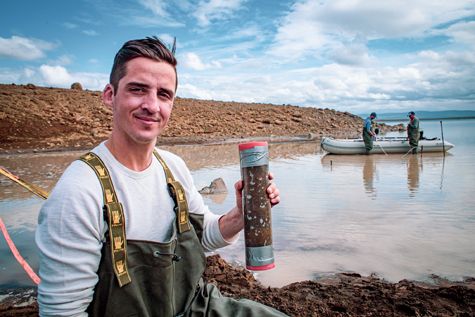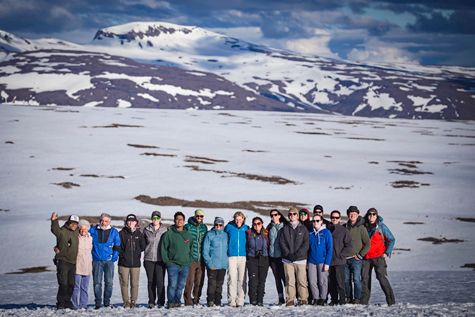Early Career Scientist Spotlight
Dr. Michael Thorpe (he/him/his)
Sedimentary and Planetary Geologist
Planetary Environments Laboratory (699)
What inspired you to pursue a career in Sedimentary and Planetary Geology?
When I was younger, hiking in the beautiful mountains surrounding the Hudson River Valley of New York inspired me to pursue a career that would keep me outdoors. I knew I was more cut out for everyday flannels versus a shirt and tie. However, I never envisioned that my passion for the environment would one day land me at NASA and working with rovers on Mars. Along the way, I have met some truly incredible people and have had some remarkable experiences that inspired me to chase a career in Sedimentary Geology and Planetary Exploration. On the geology side, I was inspired by a professor at Towson University that demonstrated a genuine interest in the material and was able to make it relatable in a way that resonated with me. Dr. Lev stood out as a mentor for me and helped shape my ambitions for graduate school. In graduate school, my planetary exploration side was first encouraged by my masters mentor, Dr. Deanne Rogers. Deanne allowed me to stay grounded and work with rocks on Earth but tested me to make comparisons with Mars, and this Martian background opened a whole new world of research for me. Then my Ph.D. advisor, Dr. Joel Hurowitz, helped me run with that newly developed planetary motivation to investigate Martian analog environments and compare these results to rover findings. It all came full circle when I recognized my skillset in sedimentary geology was equally as important for Mars as it was for Earth. My jump to NASA was then supported by a postdoctoral fellowship that I was awarded and another advisor, Dr. Liz Rampe, who continued this strong lineage of amazing mentorship that I was so fortunate to have over the years. Truth be told, a huge part of my continued inspiration in this field is to pay it forward one day and mentor the next generation of scientist. I would also be remiss if I didn’t acknowledge the most inspirational group of people in my life and that’s my family. My family motivates and supports me beyond words. As my wife’s favorite artist would sing, “when the bones are good, the rest don’t matter.”
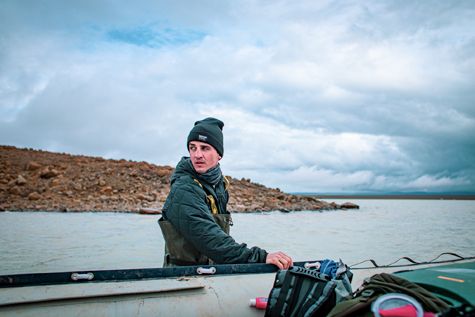
Credit: Iceland Space Agency
What science questions do you investigate?
My research focuses how sediments are transformed all the way from mountains to lakes, in a process geologist like to call source-to-sink. I travel around the world to explore how this source-to-sink process is impacted by various climates, particularly seeking basaltic terrains because these rocks are widespread on the surface of Mars. This relationship between rocks on Earth and rocks on Mars drives my motivation for planetary exploration. With that in mind, I am super lucky to be a part of the Mars Science Laboratory (MSL) team and to get to work with the Curiosity rover as it traverses across Gale crater. The landscape of Gale crater records a history of ancient rivers and lakes, and I investigate the mineralogy of drilled sedimentary rocks with the CheMin instrument on board the rover. I am also fortunate to be on the Mars Sample Return Campaign Science Group (MCSG) and we are getting ready to return some of the most precious samples to Earth within the next decade.
The ability for my research to bridge a gap between terrestrial sedimentary geochemistry and planetary sciences is truly exciting for me. I aim to continue filling knowledge gaps in our geological record here on Earth while also building a better reference frame for interpreting the sedimentary history of other rocky bodies in the solar system. To accomplish these lofty goals, I try to approach my research with a multidisciplinary mentality and always welcome a fun new collaboration. I start in the field, where my passion for the outdoors and hiking is fed by working in amazing environments around the globe. In these field sites, I use an array of tools, including drones and drills, to collect samples and data to bring back to home. Back in the lab, I use geochemistry, mineralogy, and sedimentology as my main tools. I focus on high resolution results for the tiniest sediments I get from the field. This will ultimately tell us the most about the source-to-sink system, but also centering in on these techniques will better prepare us for doing similar analysis on samples returned from Mars one day soon.
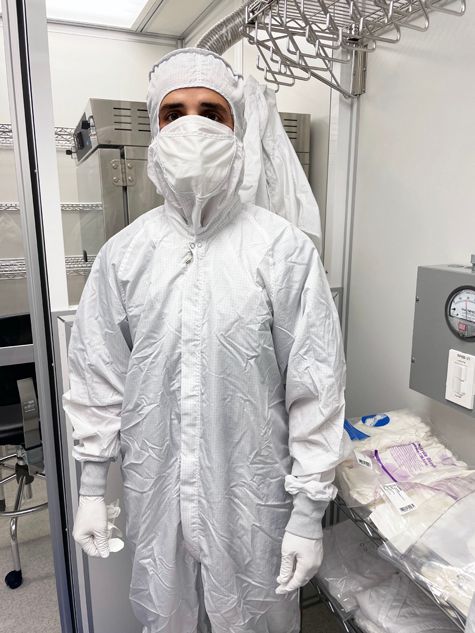
Credit: Mike Thorpe
What research accomplishment are you most proud of?
As of now, I am most proud of my DIGMARS project and the amazing team I get to work with. This project stands for “Digging Iceland Geology for Mars Analog Research Science” and it was the first NASA proposal I ever wrote as a Science Principal Investigator (PI). I am proud of the DIGMARS project because it brings together an amazing group of scientists and collaborators who worked incredibly hard together in the field for two exciting field campaigns back-to-back in 2021 and 2022. This project really highlights how teamwork makes the dream work! We were hiking to extreme locations in Iceland next to glaciers, drilling sediment cores off a floating drill rig, and sampling ground and lake waters from the side of a boat. My favorite part about our trips was catching up at the end of each exhausting day during our “family dinners” to hear how my team did in the field that day.
Credit: Iceland Space Agency
What do you enjoy the most about your job?
I love to explore new field sites but the most enjoyable thing about my job is getting to work with some amazing teams. For example, on the MSL team, we have an incredible group of scientists but also remarkable engineers. Daily operations require input from both sides and it’s truly amazing to watch how cohesive and smooth the rover runs because of this teamwork attitude. Growing up, I always played team sports and loved it beyond words sometimes. But to now sit on rosters of science teams around the globe is equally as exciting for me. The diversity in personnel, ideas, specialties, skill levels, and experience brings together an unparalleled approach for planetary exploration. I look forward to continuing to build an inclusive environment for all my future research endeavors because it makes for the most impactful, and enjoyable science.
What is one space mission that you are particularly excited about, and why?
I am extremely excited for Mars Sample Return (MSR), which is a multi-launch mission and a collaboration between NASA and the European Space Agency. From a certain vantage point, I am a sample scientist and while the rovers and their on-board instruments are amazing, I know how much more incredible information we can actually get from having a sample “in hand.” Back in our sophisticated labs here on Earth, we can interrogate these MSR samples and unravel significantly more information about their geological history. In fact, some of the best labs, techniques, and instrumentation that will be used for analyzing these samples from MSR are likely not even conceptualized yet. That should get the next generation of scientists pretty excited! I know I am sitting on the edge of my seat and I hope to play a key role in piecing together the sedimentary history from the most precious samples to come back to Earth.
What keeps you inspired by your work?
The inspiration for my work is really seated in a genuine curiosity on how the environment shapes the surface. As I dove deeper into geology, the bigger picture started to become a lot clearer. The connection between modern rock weathering, the carbon cycle, and the ancient rock record brings everything full circle for me. Then, the fact that I can take my skillset and apply this to other rocky bodies, like Mars, is something I never could have dreamt of. In a way, I study contemporary processes on Earth to better understand ancient processes on Mars, but in return, by studying early Mars, it also helps us better understand ancient Earth. It is such an exciting role to be in and sometimes I feel like I am riding a wave that I hope never ends.
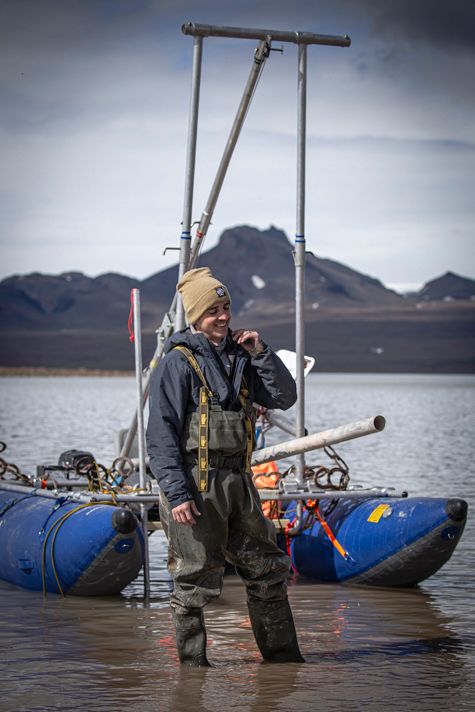
Credit: Iceland Space Agency
If you were to expand your current research focus, what new topics would you explore?
Expanding research into new fields is one of the more exciting things as a scientist. Sometimes I feel like I need to pump the breaks because I get too thrilled about a new idea. However, in the future, I would like to broaden both the Earth and planetary sides of my research fields. On the Earth side, I would like to dive deeper into the ancient rock record and investigate some key shifts in Earth’s history. I focus on clay minerals and there are still some fascinating stories to unravel with their prevalence throughout time. I also would like to apply my knowledge of rock weathering to better understanding climate change. The rocks of focus on Earth are mafic and are pretty good at sequestering carbon into the rock record. I am hoping some collaborations with climate scientists can put these tools to work. On the planetary side, I would love to work with astronauts and train them for doing “field work” on other rocky bodies in the solar system. I also dream of working on instrument development for exploring other planets and eventually leading a team to explore the geochemistry and mineralogy of a new foreign terrain in the solar system.

Credit: Mike Thorpe
What is a fun fact about you?
A fun fact about me is that I love to cook. I think this passion started sometime early in my childhood and I have carried it over to cooking meals for my growing family. For me, cooking is a relaxing hobby, and it makes me happy to see folks enjoy the food I prepare. Not to mention, cooking also brings a degree of science, particularly chemistry, into play, which excites the nerdy side of me. Cooking is also an activity that my wife loves, which makes for a fun date night experimenting new recipes in the kitchen together. I am also a big fan of “pizza Fridays” and “Sunday Dinner” and anyone is free to pull up a chair at the Thorpe household for a home cooked meal.
Biography
Home Town:
Cold Spring, NY
Undergraduate Degree:
B.S. in Geology, Towson University, Towson, MD
Post-graduate Degrees:
M.S. and Ph.D. in Geosciences, Stony Brook University, Stony Brook, NY
